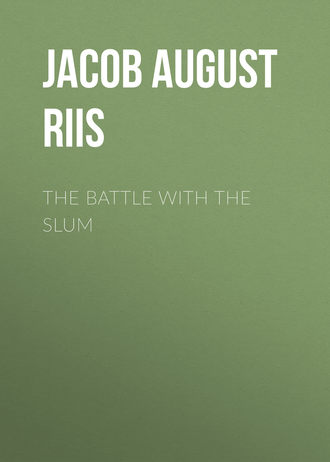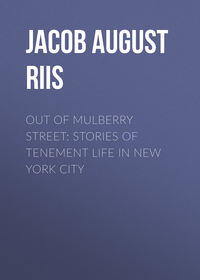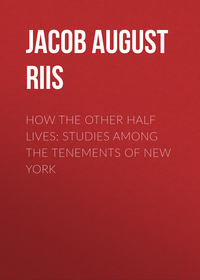 полная версия
полная версияThe Battle with the Slum
Many a mile I might lead you along these rivers, east and west, through the island of Manhattan, and find little else than we have seen. The great crowd is yet below Fourteenth Street, but the northward march knows no slackening of pace. As the tide sets up-town, it reproduces faithfully the scenes of the older wards, though with less of their human interest than here, where the old houses, in all their ugliness, have yet some imprint of the individuality of their tenants. Only on feast days does Little Italy, in Harlem, recall the Bend when it put on holiday attire. Anything more desolate and disheartening than the unending rows of tenements, all alike and all equally repellent, of the up-town streets, it is hard to imagine. Hell's Kitchen in its ancient wickedness was picturesque, at least, with its rocks and its goats and shanties. Since the negroes took possession it is only dull, except when, once in a while, the remnant of the Irish settlers make a stand against the intruders. Vain hope! Perpetual eviction is their destiny. Negro, Italian, and Jew, biting the dust with many a bruised head under the Hibernian's stalwart fist, resistlessly drive him before them, nevertheless, out of house and home. The landlord pockets the gate money. The old robbery still goes on. Where the negro pitches his tent, he pays more rent than his white neighbor next door, and is a better tenant. And he is good game forever. He never buys the tenement, as the Jew or the Italian is likely to do when he has scraped up money enough to reënact, after his own fashion, the trick taught him by his oppressor. The black column has reached the hundredth street on the East Side, and the sixties on the West,19 and there for the present it halts. Jammed between Africa, Italy, and Bohemia, the Irishman has abandoned the East Side up-town. Only west of Central Park does he yet face his foe, undaunted in defeat as in victory. The local street nomenclature, in which the directory has no hand,—Nigger Row, Mixed Ale Flats, etc.,—indicates the hostile camps with unerring accuracy.
Up-town or down-town, as the tenements grow taller, the thing that is rarest to find is the home of the olden days, even as it was in the shanty on the rocks. "No home, no family, no manhood, no patriotism!" said the old Frenchman. Seventy-seven per cent of their young prisoners, say the managers of the state reformatory, have no moral sense, or next to none. "Weakness, not wickedness, ails them," adds the prison chaplain; no manhood, that is to say. It is the stamp of the home that is lacking, and we need to be about restoring it, if we would be safe. Years ago, roaming through the British Museum, I came upon an exhibit that riveted my attention as nothing else had. It was a huge stone arm, torn from the shoulder of some rock image, with doubled fist and every rigid muscle instinct with angry menace. Where it came from or what was its story I do not know. I did not ask. It was its message to us I was trying to read. I had been spending weary days and nights in the slums of London, where hatred grew, a noxious crop, upon the wreck of the home. Lying there, mute and menacing, the great fist seemed to me like a shadow thrown from the gray dawn of the race into our busy day with a purpose, a grim, unheeded warning. What was it? In the slum the question haunts me yet. They perished, the empires those rock-hewers built, and the governments reared upon their ruins are long since dead and forgotten. They were born to die, for they were not built upon human happiness, but upon human terror and greed. We built ours upon the bed rock, and its cornerstone is the home. With this bitter mockery of it that makes the slum, can it be that the warning is indeed for us?
CHAPTER V
"DRUV INTO DECENCY"
I stood at Seven Dials and heard the policeman's account of what it used to be. Seven Dials is no more like the slum of old than is the Five Points to-day. The conscience of London wrought upon the one as the conscience of New York upon the other. A mission house, a children's refuge, two big schools, and, hard by, a public bath and a wash-house, stand as the record of the battle with the slum, which, with these forces in the field, has but one ending. The policeman's story rambled among the days when things were different. Then it was dangerous for an officer to go alone there at night.
Around the corner there came from one of the side streets a procession with banners, parading in honor and aid of some church charity. We watched it pass. In it marched young men and boys with swords and battle-axes, and upon its outskirts skipped a host of young roughs—so one would have called them but for the evidence of their honest employment—who rattled collection boxes, reaping a harvest of pennies from far and near. I looked at the battle-axes and the collection boxes, and thought of forty years ago. Where was the Seven Dials of that day, and the men who gave it its bad name? I asked the policeman.
"They were druv into decency, sor," he said, and answered from his own experience the question ever asked by faint-hearted philanthropists. "My father, he done duty here afore me in '45. The worst dive was where that church stands. It was always full of thieves,"—whose sons, I added mentally, have become collectors for the church. The one fact was a whole chapter on the slum.
London's way with the tenant we adopted at last in New York with the slum landlord. He was "druv into decency." We had to. Moral suasion had been stretched to the limit. The point had been reached where one knock-down blow outweighed a bushel of arguments. It was all very well to build model tenements as object lessons to show that the thing could be done; it had become necessary to enforce the lesson by demonstrating that the community had power to destroy houses which were a menace to its life. The rear tenements were chosen for this purpose.
They were the worst, as they were the first, of New York's tenements. The double-deckers of which I have spoken had, with all their evils, at least this to their credit, that their death-rate was not nearly as high as that of the old houses. That was not because of any virtue inherent in the double-deckers, but because the earlier tenements were old, and built in a day that knew nothing of sanitary restrictions, and cared less. Hence the showing that the big tenements had much the lowest mortality. The death-rate does not sound the depths of tenement-house evils, but it makes a record that is needed when it comes to attacking property rights. The mortality of the rear tenements had long been a scandal. They are built in the back yard, generally back to back with the rear buildings on abutting lots. If there is an open space between them, it is never more than a slit a foot or so wide, and gets to be the receptacle of garbage and filth of every kind; so that any opening made in these walls for purposes of ventilation becomes a source of greater danger than if there were none. The last count that was made, in 1900, showed that among the 44,850 tenements in Manhattan and the Bronx there were still 2143 rear houses left.20 Where they are the death-rate rises, for reasons that are apparent. The sun cannot reach them. They are damp and dark, and the tenants, who are always the poorest and most crowded, live "as in a cage open only toward the front." A canvass made of the mortality records by Dr. Roger S. Tracy, the registrar of records, showed that while in the First Ward (the oldest), for instance, the death-rate in houses standing singly on the lot was 29.03 per 1000 of the living, where there were rear houses it rose to 61.97. The infant death-rate is a still better test; that rose from 109.58 in the single tenements of the same ward to 204.54 where there were rear houses.21 One in every five babies had to die; that is to say, the house killed it. No wonder the Gilder commission styled the rear tenements "slaughter-houses," and called upon the legislature to root them out, and with them every old, ramshackle, disease-breeding tenement in the city.
A law which is in substance a copy of the English act for destroying slum property was passed in the spring of 1895. It provided for the seizure of buildings that were dangerous to the public health or unfit for human habitation, and their destruction upon proper proof, with compensation to the owner on a sliding scale down to the point of entire unfitness, when he might claim only the value of the material in his house. Up to that time, the only way to get rid of such a house had been to declare it a nuisance under the sanitary code; but as the city could not very well pay for the removal of a nuisance, to order it down seemed too much like robbery; so the owner was allowed to keep it. It takes time and a good many lives to grow a sentiment such as this law expressed. The Anglo-Saxon respect for vested rights is strong in us also. I remember going through a ragged school in London, once, and finding the eyes of the children in the infant class red and sore. Suspecting some contagion, I made inquiries, and was told that a collar factory next door was the cause of the trouble. The fumes from it poisoned the children's eyes.

Richard Watson Gilder, Chairman of the Tenement House Commission of 1894.
"And you allow it to stay, and let this thing go on?" I asked, in wonder.
The superintendent shrugged his shoulders. "It is their factory," he said.
I was on the point of saying something that might not have been polite, seeing that I was a guest, when I remembered that, in the newspaper which I carried in my pocket, I had just been reading a plea of some honorable M. P. for a much-needed reform in the system of counsel fees, then being agitated in the House of Commons. The reply of the solicitor general had made me laugh. He was inclined to agree with the honorable member, but still preferred to follow precedent by referring the matter to the Inns of Court. Quite incidentally, he mentioned that the matter had been hanging fire in the House two hundred years. It seemed very English to me then; but when we afterward came to tackle our rear tenements, and in the first batch there was a row which I knew to have been picked out by the sanitary inspector twenty-five years before as fit only to be destroyed, I recognized that we were kin, after all.
That was Gotham Court. It was first on the list, and the Mott Street Barracks came next, when, as executive officer of the Good Government Clubs, I helped the Board of Health put the law to the test the following year. Roosevelt was Police President and Health Commissioner; nobody was afraid of the landlord. The Health Department kept a list of 66 old houses, with a population of 5460 tenants, in which there had been 1313 deaths in a little over five years (1889-94). From among them we picked our lot, and the department drove the tenants out. The owners went to law, one and all; but, to their surprise and dismay, the courts held with the health officers. The moral effect was instant and overwhelming. Rather than keep up the fight, with no rent coming in, the landlords surrendered at discretion. In consideration of this, compensation was allowed them at the rate of about a thousand dollars a house, although they were really entitled only to the value of the old bricks. The buildings all came under the head of "wholly unfit." Gotham Court, with its sixteen buildings, in which, many years before, a health inspector counted 146 cases of sickness, including "all kinds of infectious disease," was bought for $19,750, and Mullen's Court, adjoining, for $7251. To show the character of all, let two serve; in each case it is the official record, upon which seizure was made, that is quoted:
No. 98 Catherine Street: "The floor in the apartments and the wooden steps leading to the second-floor apartment are broken, loose, saturated with filth. The roof and eaves gutters leak, rendering the apartments wet. The two apartments on the first floor consist of one room each, in which the tenants are compelled to cook, eat, and sleep. The back walls are defective, the house wet and damp, and unfit for human habitation. It robs the surrounding houses of light."
"The sunlight never enters" was the constant refrain.
No. 17 Sullivan Street: "Occupied by the lowest whites and negroes, living together. The houses are decayed from cellar to garret, and filthy beyond description,—the filthiest, in fact, we have ever seen. The beams, the floors, the plaster on the walls, where there is any plaster, are rotten, and alive with vermin. They are a menace to the public health, and cannot be repaired. Their annual death-rate in five years was 41.38."

The Mott Street Barracks.
The sunlight enters where these stood, at all events, and into 58 other yards that once were plague spots. Of 94 rear tenements seized that year, 60 were torn down, 33 of them voluntarily by the owners; 29 were remodelled and allowed to stand, chiefly as workshops; 5 other houses were standing empty, and yielding no rent, when I last heard of them. I suppose they have been demolished since. The worst of them all, the Mott Street Barracks, were taken into court by the owner; but all the judges and juries in the land had no power to put them back when it was decided upon a technicality that they should not have been destroyed offhand. It was a case of "They can't put you in jail for that."—"Yes, but I am in jail." They were gone, torn down under the referee's decision that they ought to go, before the Appellate Division called a halt. We were not in a mood to trifle with the Barracks, or risk any of the law's delays. In 1888 I counted 360 tenants in these tenements, front and rear, all Italians, and the infant death-rate of the Barracks that year was 325 per 1000. There were forty babies, and one in three of them had to die. The general infant death-rate for the whole tenement-house population that year was 88.38. In the four years following, during which the population and the death-rate of the houses were both reduced with an effort, fifty-one funerals went out of the Barracks. With entire fitness, a cemetery corporation held the mortgage upon the property. The referee allowed it the price of opening one grave, in the settlement, gave one dollar to the lessee, and one hundred and ten dollars to the landlord, who refused to collect and took his case into the courts. We waited to see the landlord attack the law itself on the score of constitutionality, but he did not. The Court of Appeals decided that it had not been shown that the Barracks might not have been used for some other purpose than a tenement and that therefore we had been hasty. The city paid damages, but it was all right. It was emphatically a case of haste making for speed. So far the law stands unchallenged, both here and in Massachusetts, where they destroyed twice as many unfit houses as we did in New York and stood their ground on its letter, paying the owners the bare cost of the old timbers.
As in every other instance, we seized only the rear houses at the Barracks; but within a year or two the front houses were also sold and destroyed too, and so disappeared quite the worst rookery that was left on Manhattan Island. Those of us who had explored it with the "midnight police" in its worst days had no cause to wonder at its mortality. In Berlin they found the death-rate per thousand to be 163.5 where a family occupied one room, 22.5 where it lived in two rooms, 7.5 in the case of three-room dwellers, and 5.4 where they had four rooms.22 Does any one ask yet why we fight the slum in Berlin and New York? The Barracks in those days suggested the first kind.
I have said before that I do not believe in paying the slum landlord for taking his hand off our throats, when we have got the grip on him in turn. Mr. Roger Foster, who as a member of the Tenement House Committee drew the law, and as counsel for the Health Department fought the landlords successfully in the courts, holds to the opposite view. I am bound to say that instances turned up in which it did seem a hardship to deprive the owners of even such property. I remember especially a tenement in Roosevelt Street, which was the patrimony and whole estate of two children. With the rear house taken away, the income from the front would not be enough to cover the interest on the mortgage. It was one of those things that occasionally make standing upon abstract principle so very uncomfortable. I confess I never had the courage to ask what was done in their case. I know that the tenement went, and I hope—well, never mind what I hope. It has nothing to do with the case. The house is down, and the main issue decided upon its merits.
In the 94 tenements (counting the front houses in; they cannot be separated from the rear tenements in the death registry) there were in five years 956 deaths, a rate of 62.9 at a time when the general city death-rate was 24.63. It was the last and heaviest blow aimed at the abnormal mortality of a city that ought, by reason of many advantages, to be one of the healthiest in the world. With clean streets, pure milk, medical school inspection, antitoxin treatment of deadly diseases, and better sanitary methods generally; with the sunlight let into its slums, and its worst plague spots cleaned out, the death-rate of New York came down from 26.32 per 1000 inhabitants in 1887 to 19.53 in 1897. Inasmuch as a round half million was added to its population within the ten years, it requires little figuring to show that the number whose lives were literally saved by reform would people a city of no mean proportions. The extraordinary spell of hot weather in the summer of 1896, when the temperature hung for ten consecutive days in the nineties, with days and nights of extreme discomfort, brought out the full meaning of this. While many were killed by sunstroke, the population as a whole was shown to have acquired, in better hygienic surroundings, a much greater power of resistance. It yielded slowly to the heat. Where two days had been sufficient, in former years, to send the death-rate up, it now took five; and the infant mortality remained low throughout the dreadful trial. Perhaps the substitution of beer for whiskey as a summer drink had something to do with it; but Colonel Waring's broom and unpolitical sanitation had more. Since it spared him so many voters, the politician ought to have been grateful for this; but he was not. Death-rates are not as good political arguments as tax rates, we found out. In the midst of it all, a policeman whom I knew went to his Tammany captain to ask if Good Government Clubs were political clubs within the meaning of the law which forbade policemen joining such. The answer he received set me to thinking: "Yes, the meanest, worst kind of political clubs, they are." Yet they had done nothing worse than to save the babies, the captain's with the rest.
The landlord read the signs better, and ran to cover till the storm should blow over. Houses that had hardly known repairs since they were built were put in order with all speed. All over the city, he made haste to set his house to rights, lest it be seized or brought to the bar in other ways. The Good Government Clubs had their hands full that year (1896-97). They made war upon the dark hall in the double-decker, and upon the cruller bakery. They compelled the opening of small parks, or the condemnation of sites for them anyway, exposed the abuses of the civil courts, the "poor man's courts," urged on the building of new schools, cleaned up in the Tombs prison and hastened the demolition of the wicked old pile, and took a hand in evolving a sensible and humane system of dealing with the young vagrants who were going to waste on free soup. The proposition to establish a farm colony for their reclamation was met with the challenge at Albany that "we have had enough reform in New York City," and, as the event proved, for the time being we had really gone as far as we could. But even that was a good long way. Some things had been nailed that could never again be undone; and hand in hand with the effort to destroy had gone another to build up, that promised to set us far enough ahead to appeal at last successfully to the self-interest of the builder, if not to his humanity; or, failing that, to compel him to decency. If that promise has not been all kept, the end is not yet. I believe it will be kept.

R. Fulton Cutting, Chairman of the Citizens' Union.
The movement for reform, in the matter of housing the people, had proceeded upon a clearly outlined plan that apportioned to each of several forces its own share of the work. At a meeting held under the auspices of the Association for Improving the Condition of the Poor, early in the days of the movement, the field had been gone over thoroughly. To the Good Government Clubs fell the task, as already set forth, of compelling the enforcement of the existing tenement-house laws. D. O. Mills, the philanthropic banker, declared his purpose to build hotels which should prove that a bed and lodging as good as any could be furnished to the great army of homeless men at a price that would compete with the cheap lodging houses, and yet yield a profit to the owner. On behalf of a number of well-known capitalists, who had been identified with the cause of tenement-house reform for years, Robert Fulton Cutting, the president of the Association for Improving the Condition of the Poor, offered to build homes for the working people that should be worthy of the name, on a large scale. A company was formed, and chose for its president Dr. Elgin R. L. Gould, author of the government report on the "Housing of the Working People," the standard work on the subject. A million dollars was raised by public subscription, and operations were begun at once.
Two ideas were kept in mind as fundamental: one, that charity that will not pay will not stay; the other, that nothing can be done with the twenty-five-foot lot. It is the primal curse of our housing system, and any effort toward better things must reckon with it first. Nineteen lots on Sixty-eighth and Sixty-ninth streets, west of Tenth Avenue, were purchased of Mrs. Alfred Corning Clark, who took one tenth of the capital stock of the City and Suburban Homes Company; and upon these was erected the first block of tenements. This is the neighborhood toward which the population has been setting with ever increasing congestion. Already in 1895 the Twenty-second Ward contained nearly 200,000 souls. I gave figures in the previous chapter that showed a crowding of more than 1100 persons per acre in some of the blocks here where the conditions of the notorious Tenth Ward are certain to be reproduced, if indeed they are not exceeded. In the Fifteenth Assembly District, some distance below, but on the same line, the first sociological canvass of the Federation of Churches had found the churches, schools, and other educational agencies marshalling a frontage of 756 feet on the street, while the saloon fronts stretched themselves over nearly a mile; so that, said the compiler of these pregnant facts, "saloon social ideals are minting themselves on the minds of the people at the ratio of seven saloon thoughts to one educational thought." It would not have been easy to find a spot better fitted for the experiment of restoring the home to its place.

Alfred Corning Clark Buildings.
The Alfred Corning Clark buildings, as they were called in recognition of the effort of this public-spirited woman, have at this writing been occupied five years. They harbor nearly four hundred families, as contented a lot as I ever saw anywhere. The one tenant who left in disgust was a young doctor who had settled on the estate, thinking he could pick up a practice among so many. But he couldn't. They were not often sick, those tenants. Last year only three died, and they were all killed while away from home. So he had good cause of complaint. The rest had none, and having none, they stay, which is no mean blow struck for the home in the battle with the slum. The home feeling can never grow where people do not stay long enough to feel at home, any more than the plant can which the child is pulling up every two or three days to "see if it has roots."











